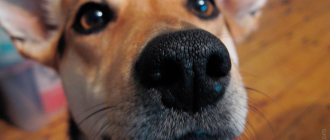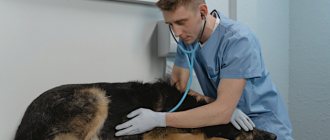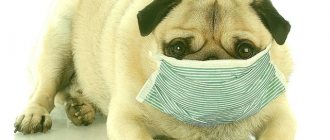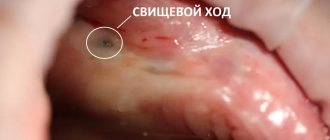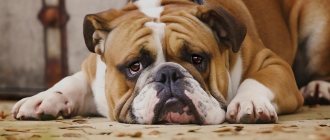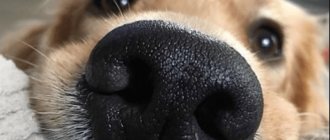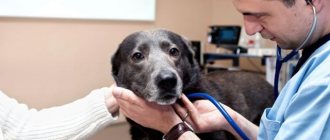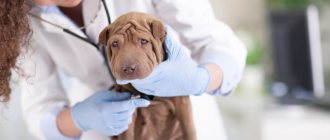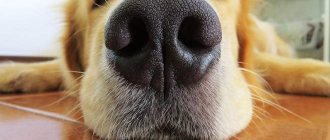Causes of dry nose in pets
The inner and outer surfaces of the nose have a similar structure. The cells produce a special secretion that protects the mucous membranes and skin from drying out. Often, dogs' noses become dry for completely natural reasons . If dryness is not accompanied by other alarming symptoms, then there is no need to worry. Most likely, the normal state will be restored after some time.
- Sleep and 10-15 minutes after waking up. During sleep, body temperature rises slightly, which causes the nose and mucous membranes to dry out. Humidity is restored after waking up.
- Overexcitement . Any strong emotions such as fear, stress or the excitement of the hunt can lead to fever and dry nose. Once the cause is eliminated, the body will recover. In some cases, the animal may require the help of a specialist.
- Fatigue or overwork . After running or active training, most dogs experience an increase in temperature, dry mucous membranes and nose. This condition will pass after the pet rests, drinks and calms down.
- Hormonal imbalances . Natural disruptions in the functioning of the endocrine system occur during pregnancy, lactation and sexual heat. This is a normal natural process that does not require specialist intervention.
- Reactions to vaccinations and medications . Sometimes dogs experience a dry nose after vaccinations, anesthesia or injections. This is due to stress and the body's natural reactions to the foreign substance.
- Heredity , also known as genetic predisposition. Some animals have reduced secretion, which is why the nose often becomes dry. These are individual characteristics that are not a deviation. This nose is called passive.
- Weather . Hot or frosty weather affects secretion production. Pets should be protected from overheating and hypothermia.
- Microclimate . Dry air during the heating season negatively affects not only the condition of the mucous membranes, but also general well-being. In winter, additional humidification of the premises is necessary.
- Baby teeth . Changing baby teeth affects the general condition of the puppy. Sometimes the body temperature rises slightly, which leads to dry mucous membranes. After changing teeth, the condition returns to normal.
- Injuries . The injury may be accompanied by an increase in temperature and, as a consequence, dryness of the nose. After the pain has been eliminated and the temperature has dropped, the humidity is restored within a few hours.
- Age characteristics . A dry nose is normal for older dogs and young puppies. This is due to decreased (old dogs) and increased (puppies) metabolism in the body.
Dry nose that occurs due to natural causes is short-lived and does not require treatment. But if the dog’s general condition is suspicious, you should contact the clinic for advice.
Anatomical features
The dog's nose is almost always wet and cool. The famous zoologist Knut Schmidt-Nielsen put forward his theory of why dogs have wet noses. He claims that our four-legged friends do not have sweat glands, and a wet nose saves them from overheating.
During rapid breathing in extreme heat, the dog sticks out its tongue, thus increasing cooling. At this time, the nose takes an active part in heat exchange. The mucus that is constantly secreted helps a moist nose to detect odors. Therefore, it is the dog that has an excellent sense of smell, thanks to which it orients itself in space. Naturally, the loss of this opportunity will affect the dog’s behavior.
What diseases can cause a dry nose?
Sometimes a very dry nose in a dog can be a sign of a serious illness. You should contact your veterinarian if your nose is dry for more than a day or if there are signs of deterioration in your general condition. Associated symptoms may include lethargy, lack of appetite, fever, dry mouth, rapid breathing and palpitations. As well as nasal discharge, cough, diarrhea or vomiting.
Nose is dry and warm or hot
Often, an increase in body temperature and, as a result, a dry nose are the primary signs of inflammation in the dog’s body. It should be borne in mind that some diseases occur rapidly and can lead to the death of a pet in just 3-4 days. Therefore, you should not self-medicate; in such a situation, you must urgently seek help. The veterinarian will conduct a full diagnosis, take tests and make a diagnosis.
Diseases and associated symptoms:
- Helminthic infestation (parasitosis) . Symptoms: disturbances in the gastrointestinal tract, lethargy, thirst, fever, increased abdominal volume. In some cases, coughing and vomiting.
- Pemphigus is an autoimmune dermatological pathology, which is characterized by the appearance of blisters filled with liquid. Blisters, pustules, sores and cracks can appear on the dog's nose, mouth, paws and stomach. In the absence of timely treatment, the bubbles burst, and pathogenic microflora enters the wounds. This significantly complicates the treatment and healing processes.
- A dry, crusty nose may be a sign of a disease such as lupus. Accompanied by swelling of the mucous membrane, inflammation, lack of appetite, pain and itching.
- Colds . Symptoms: lethargy, wheezing, cough, nasal discharge, lack of appetite, fever .
- Allergies may be accompanied by lethargy, sneezing, nasal discharge, lacrimation, refusal to feed, hyperemia or pallor of the mucous membranes.
- Poisoning with toxins (poisons), chemicals . Symptoms: vomiting, diarrhea, rapid breathing and palpitations. In some cases, apathy, refusal of water and food, lethargy, weak pulse, shallow breathing. In case of poisoning, assistance must be provided immediately.
- Vitamin deficiency - a lack of vitamins in the body can be characterized by lethargy, loss of appetite, perverted taste (eating plastic, stones, feces, etc.), baldness, muscle tremors, convulsions, loss of vision.
- Carnivore plague . Symptoms: weakness, purulent discharge from the nose and eyes, diarrhea, vomiting, depression, refusal of food and water. It is recommended to immediately seek help from a veterinary clinic.
- Endometritis usually affects young, unvaccinated dogs under 6 months of age. Symptoms: lethargy, apathy, refusal to feed, vomiting and diarrhea mixed with blood and a putrid odor, discharge from the nose and eyes. If there is no help, the animal dies within 3 days.
- Rabies is a dangerous, fatal disease. Cannot be treated. Extremely dangerous for both dogs and owner. Symptoms: Lethargy, depressed state, signs of unreasonable cowardice or aggression, drooling, convulsions, discharge from the nose and eyes, photophobia, unsteady gait. It is necessary to isolate the patient in a separate room until the specialist arrives. To prevent infection with a dangerous infection, you need to vaccinate your animal on time.
- A dry and cold nose can be a symptom of cardiovascular disease, dehydration, or internal bleeding. Associated symptoms: weakness, cold paws and ears, shortness of breath, refusal to eat, thirst.
Dry nose can accompany diabetes, kidney failure, bladder inflammation, gastrointestinal disorders and other diseases.
Lethargy as an additional symptom
A symptom such as lethargy can be considered a cause for concern . It is characterized by the fact that the pet does not respond to the name and commands, loses activity and does not show interest during a walk, constantly lies down, does not eat or drink. In difficult situations, the animal practically does not react to external stimuli, such as noise, light, or the presence of strangers.
Briefly about the main thing
- A healthy dog's nose is cold and moderately moist.
- Dryness is explained by limited sweat production or its complete cessation, but does not always signal illness.
- The symptom of dry nose in pathological conditions and diseases of the animal’s body does not appear alone.
- To prevent the risk of disease, you need to regularly monitor walking areas, the amount of fluid consumed, and also prevent overheating or hypothermia.
- If a problem occurs, you should immediately contact a specialist.
What to do and how to help your pet
First of all, you need to determine the cause of dryness. To do this, gradually eliminate all possible related factors. Most likely, the reason lies in the natural reaction of the body and does not require outside intervention. The pet needs to create conditions for recovery. Give drink, calm, provide rest and peace.
If additional symptoms are revealed during examination and observation, it is best to take the dog to see a veterinarian. Some medications can only be used as prescribed by a doctor. It should be remembered that an incorrectly prescribed course and dosage can aggravate the situation. Therefore, self-medication is extremely undesirable.
At the appointment, problems and symptoms cannot be hushed up. Collecting medical history (information) is very important for making a diagnosis. It is necessary to remember and provide the doctor with all the necessary information. If the dog, for example, belongs to friends, grandmother, parents, then you need to prepare in advance for the survey and find out all the details about care, feeding and maintenance. You should also not wipe off the discharge or give medications. This can blur the picture of the disease.
When to see a doctor:
- Increase or decrease the temperature by 1–2 °C. The norm depends on the breed and age, ranging from 37 to 39 °C.
- Violation of urination and defecation, such as a decrease in the daily norm, constipation, diarrhea, pain and other abnormalities.
- Refusal of food and water.
- Vomiting, constant retching.
- Pain on palpation (palpation).
- Blood in urine, feces, vomit.
- Lethargy, apathy, weakness. Lack of response to external stimuli.
- Muscle tremors.
- Drooling, foam.
- Convulsions, loss of coordination.
- Paleness or hyperemia of the mucous membranes.
- Copious purulent discharge from the nose and eyes.
- A sharp change in mood from cowardice to aggression.
- Photophobia, hydrophobia.
- Loss of consciousness.
- Rapid breathing and heart rate at rest.
- Shortness of breath, severe coughing and sneezing.
- Paralysis of limbs.
After diagnosis and test results, the doctor will prescribe a course of treatment and preventive procedures. It is necessary to adhere to the recommendations and follow the instructions received. Any deviations may cause an exacerbation of the disease or reduce the therapeutic effect.
Treatment methods:
- Antiviral and antibiotics are prescribed for infectious and viral diseases.
- Sedatives to suppress fear and stress.
- Anthelmintic drugs.
- In case of poisoning, rinsing and immunostimulating drugs are prescribed.
- Vaccination for preventive purposes.
- Surgical intervention to eliminate tumors, injuries, kidney stones, etc.
- Antihistamines for allergic reactions. This therapy only works when the allergen is eliminated.
- Adjustment of diet, diet.
- A course of vitamins to maintain the body and treat vitamin deficiencies.
During treatment and rehabilitation, it is necessary to provide the pet with suitable care and care. The dog should be protected from drafts and overheating. And also keep the bowls and room clean.
Ways to solve the problem
Treatment of the condition is always targeted, that is, directly related to the cause that caused tissue cracking. This is why treating an animal at home is not only useless, but also dangerous.
First, the cause of the disease is determined, and depending on it, medications and procedures are prescribed. Locally you can lubricate the dry surface with Trivit - a solution of vitamins, ointments as prescribed by a doctor. It is necessary to exclude the possibility of rubbing or injury by the muzzle when wearing a large fetch, working on the scent, and so on.
The dog needs to be kept clean, calm, well fed and given the full course of treatment prescribed by the doctor.
Bacterial infection. Treatment of bacterial infection
A bacterial infection is dangerous for pets because it can bring a huge number of negative consequences. The reasons for the appearance and manifestation of this disease can be varied:
- Injury to the skin.
- Weakening of the body's immune system.
- Flea and tick attack.
- Poor nutrition.
- Stressful situations.
- Allergic reaction.
- Pre-existing diseases.
- Living in a polluted environment.
Before starting treatment, it is recommended to visit doctors and take the necessary tests. Antibiotics are generally prescribed, but their effectiveness depends on the location of the injury and the progression of the disease. Compresses are also applied to areas that are most affected by the developing bacterial infection.
If the disease cannot be cured by the above methods, then surgical intervention is used, after which the dog must undergo an additional full course of rehabilitation.
Allergy. Treatment of an allergic reaction
The manifestation of an allergic reaction can be varied and in completely different places. Since the animal’s body can react completely unpredictably to substances that are safe at first glance, you should be vigilant and provide first aid to your pet. An allergy can leave its mark not only on the internal organs of the animal, it can also affect the appearance of the pet. So, one of the manifestations is peeling of the upper cover of the muzzle.
Self-medication of allergic reactions is categorically not recommended, since to establish the reasons that caused the allergy, you will need to do a considerable number of tests, such as:
- Mycological and bacteriological cultures.
- Trichoscopy.
- Take scrapings.
- Cytological studies.
- Nutritional research.
Therefore, if you suspect an allergy, it is best to immediately contact qualified specialists.
Symptoms of molluscum contagiosum
The incubation period of the disease ranges from two weeks to several months, but most often the rash appears on the 14-15th day.
At first, single rashes appear, then there are more of them. Molluscum contagiosum can affect any area of the skin except the palms and soles. In children, exposed areas of the arms and legs, as well as the face and neck are most often affected. In adults, the genital area and the inner thighs are most often affected.
In the typical form of the disease, the rashes are located only in one anatomical area; in the generalized form, they spread throughout the body.
Rash
The elements of the rash look like protrusions (papules), firm and painless to the touch, pink or flesh-colored, with a pearlescent top. In the center of the papule there is a small depression, from which, when pressed, a white pasty mass is squeezed out. Papules have a round or oval shape, the size usually varies in the range of 2-5 mm, but sometimes the nodules merge, and then such formations can reach a diameter of 1 cm or more.
More about the symptom
Itching
In some cases, the rash is accompanied by itching, which intensifies when scratching. Under no circumstances should papules be scratched, as this can lead to a bacterial infection. The presence of a bacterial infection is indicated by redness of the skin around the papules, swelling, and suppuration.
More about the symptom
Received injury. Treatment of injury
An injury that a dog receives, even completely by accident, can have undesirable consequences and cause the skin on the nose to peel off. Under such circumstances, the first thing you should do is treat the injured area so that bacteria and various types of infections do not settle there. However, you should not treat the skin with an alcohol-containing substance, as this will create pain and can cause inflammation of the already irritated epidermis.
Next, you should isolate the wound using compresses and lotions.
, which must be applied every two hours. If the wound does not heal, or there is suspicion of damage to internal organs, you should immediately go to a veterinary clinic.
Prevention
As preventive measures to protect your pet from possible dangers, it is recommended:
- Avoid plastic bowls and keep them clean. Give preference to ceramics or aluminum. They do not cause allergic reactions and prevent the increased growth of bacteria. Wash the feeders after each meal without adding detergent.
- Choose high-quality food and monitor the reaction of the dog’s body. When feeding natural foods, introduce new food gradually, studying the puppies' well-being.
- Use sunscreen not only for yourself, but also for your four-legged friend. In hot weather, lubricate your nose with it, and in winter, moisturize the mucous membrane with vegetable oils.
- Do not walk your dog near allergenic plants during the flowering period.
- Attend veterinary examinations, deworming and vaccinations in a timely manner.
